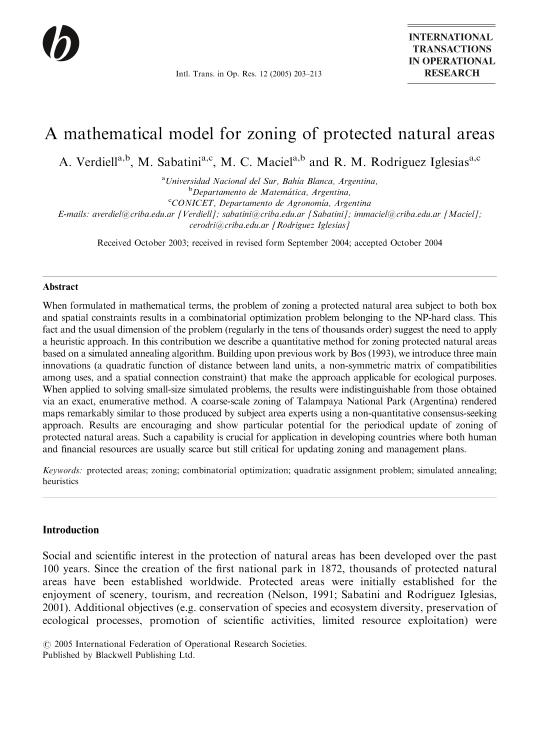Mostrar el registro sencillo del ítem
dc.contributor.author
Verdiell, Adriana Beatriz

dc.contributor.author
Sabatini, M.
dc.contributor.author
Maciel, Maria Cristina

dc.contributor.author
Rodríguez Iglesias, Ricardo Manuel

dc.date.available
2020-02-13T22:08:41Z
dc.date.issued
2005-04
dc.identifier.citation
Verdiell, Adriana Beatriz; Sabatini, M.; Maciel, Maria Cristina; Rodríguez Iglesias, Ricardo Manuel; A mathematical model for zoning of protected natural areas; Blackwell Publishing; International Transactions in Operational Research; 12; 2; 4-2005; 203-213
dc.identifier.issn
0969-6016
dc.identifier.uri
http://hdl.handle.net/11336/97527
dc.description.abstract
When formulated in mathematical terms, the problem of zoning a protected natural area subject to both box and spatial constraints results in a combinatorial optimization problem belonging to the NP-hard class. This fact and the usual dimension of the problem (regularly in the tens of thousands order) suggest the need to apply a heuristic approach. In this contribution we describe a quantitative method for zoning protected natural areas based on a simulated annealing algorithm. Building upon previous work by Bos (1993), we introduce three main innovations (a quadratic function of distance between land units, a non-symmetric matrix of compatibilities among uses, and a spatial connection constraint) that make the approach applicable for ecological purposes. When applied to solving small-size simulated problems, the results were indistinguishable from those obtained via an exact, enumerative method. A coarse-scale zoning of Talampaya National Park (Argentina) rendered maps remarkably similar to those produced by subject area experts using a non-quantitative consensus-seeking approach. Results are encouraging and show particular potential for the periodical update of zoning of protected natural areas. Such a capability is crucial for application in developing countries where both human and financial resources are usually scarce but still critical for updating zoning and management plans.
dc.format
application/pdf
dc.language.iso
eng
dc.publisher
Blackwell Publishing

dc.rights
info:eu-repo/semantics/openAccess
dc.rights.uri
https://creativecommons.org/licenses/by-nc-sa/2.5/ar/
dc.subject
COMBINATORIAL OPTIMIZATION
dc.subject
HEURISTICS
dc.subject
PROTECTED AREAS
dc.subject
QUADRATIC ASSIGNMENT PROBLEM
dc.subject
SIMULATED ANNEALING
dc.subject
ZONING
dc.subject.classification
Matemática Aplicada

dc.subject.classification
Matemáticas

dc.subject.classification
CIENCIAS NATURALES Y EXACTAS

dc.title
A mathematical model for zoning of protected natural areas
dc.type
info:eu-repo/semantics/article
dc.type
info:ar-repo/semantics/artículo
dc.type
info:eu-repo/semantics/publishedVersion
dc.date.updated
2020-02-13T14:05:20Z
dc.journal.volume
12
dc.journal.number
2
dc.journal.pagination
203-213
dc.journal.pais
Estados Unidos

dc.journal.ciudad
Hoboken
dc.description.fil
Fil: Verdiell, Adriana Beatriz. Universidad Nacional del Sur; Argentina
dc.description.fil
Fil: Sabatini, M.. Universidad Nacional del Sur. Departamento de Agronomía; Argentina
dc.description.fil
Fil: Maciel, Maria Cristina. Universidad Nacional del Sur. Departamento de Agronomía; Argentina
dc.description.fil
Fil: Rodríguez Iglesias, Ricardo Manuel. Universidad Nacional del Sur. Departamento de Agronomía; Argentina. Consejo Nacional de Investigaciones Científicas y Técnicas. Centro Científico Tecnológico Conicet - Bahía Blanca; Argentina
dc.journal.title
International Transactions in Operational Research

dc.relation.alternativeid
info:eu-repo/semantics/altIdentifier/url/https://onlinelibrary.wiley.com/doi/abs/10.1111/j.1475-3995.2005.00498.x
dc.relation.alternativeid
info:eu-repo/semantics/altIdentifier/doi/https://doi.org/10.1111/j.1475-3995.2005.00498.x
Archivos asociados
